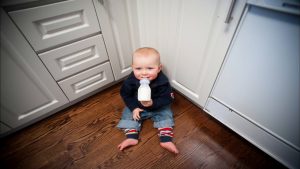Baby safety on the floor
As an adult who is used to their house it can be hard to see the potential hazards in your own home but once you think like a baby thinks you will see dangers that you need to remove in every room.
Note
Get a “baby-eye” view of the house

The Child Accident Prevention Trust recommends that if you’re able, to actually get down on your hands and your knees and scan around to see what choking hazards there might be on the floor, to get them out of your baby’s way. These include deadly dishwasher tablets on the kitchen floor and painkillers in handbags.
Another option is to fit a child resistant catch onto e.g. your kitchen and your kitchen cupboards to stop your baby being able to get access to hazards.
Look for suffocation hazards, such as nappy bags, blind cords hanging down and move everything out of reach
Move cords, flexes or items that babies can pull down something heavy, sharp or scalding on top of themselves
Once you get used to checking with your “baby-eye” view you will get into the habit of keeping those dangers out of a baby’s reach.
I think each day you spot something new and you think, oh no! you have to think about, putting the wires, behind the sofa rather than having them trailing in front. It’s just things like that, just remembering, just being conscious all the time that Isla can get around and touch things, pick things up, put things in her mouth. Raising things higher than the level that she can reach.
Like this morning, I found her in this bag, and she’d started taking things out and I’m thinking, “How did you do that? How did you get into my bag?” But it’s just being aware, I think, just consciously aware of everything around her at that given time. So, you know, whatever I do I’ve just got to just keep an eye on her, I think, all the time. You know you just can’t leave her alone for any given time.
Jane mum to Isla, 9 months
DISCLAIMER
This article is for information only and should not be used for the diagnosis or treatment of medical conditions. Essential Parent has used all reasonable care in compiling the information from leading experts and institutions but makes no warranty as to its accuracy. Consult a doctor or other health care professional for diagnosis and treatment of medical conditions. For details
click here.
